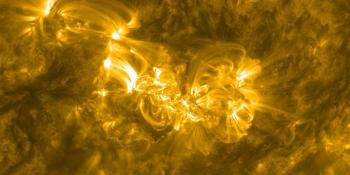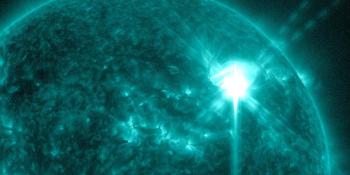Uzay Hava Tahmini - Tartışma
Yayınlandı: 2024 May 09 0030 UTC
ABD Ticaret Bakanlığı, NOAA, Uzay Hava Tahmin Merkezi tarafından hazırlanmış ve SpaceWeatherLive.com tarafından işlenmiştir.
Solar aktivite
24 s Özet
Solar activity reached very high levels. Region 3663 (N26W70, Fkc/beta-gamma) exhibited signs of decay as it approached the western limb, and appears to be losing its delta configuration. However, this region continued to produce multiple M-class flares, as well as an X1.0 flare early in the period at 08/0141 UTC, and another X1 flare that peaked at 08/2140 UTC. Region 3664 (S19W24, Fkc/beta-gamma-delta) continued to grow and evolve, eventually merging with Region 3668 (S15W13). This new combined spot group will maintain the 3664 region designation, and is now over 1,760 millionths in size. This region was responsible for an X1.0 flare at 08/0509 UTC. The X flare was accompanied by Type II and IV sweeps and a 10.7 cm radio burst. A halo CME associated with this event is first visible in C2 imagery near 08/0600 UTC. Additionally, Region 3664 produced an M8.6 flare at 08/1204 UTC, with an associated CME first visible in C2 imagery at 08/1224 UTC. Modeling of the two CMEs indicated that the second CME, with an estimated speed of nearly 800 km/s, will likely overtake the first CME, which had an estimated speed 715 km/s. The arrival time of the combined CMEs is anticipated to be late on 10 May to early on 11 May. The remaining spotted active regions were stable or in gradual decay and primarily inactive. Other activity included an approximately 35° long filament that erupted, centered near E27N18, with an associated CME, mostly moving in a northeasterly direction. Analysis and modeling of this event is currently underway.Tahmin
Solar activity is expected to persist at high to very high levels over 09-11 May, with M-class flares (R1-R2/Minor-Moderate) expected and X-class flares (R3/Strong) likely, due to the continued flare potential of Region 3663 and especially Region 3664.Enerjik Parçacıklar
24 s Özet
The greater than 2 MeV electron flux was at normal to moderate levels and the greater than 10 MeV proton flux was steady at background levels.Tahmin
The greater than 2 MeV electron flux is expected to continue at normal to moderate levels over 09-11 May. There is a chance for the greater than 10 MeV proton flux to reach S1 (Minor) storm levels over 09-11 May due to the flare potential of Regions 3663 and 3664.Güneş Rüzgarı
24 s Özet
The solar wind environment reflected near-background conditions, with the exception of slightly elevated solar wind speeds, likely attributed to residual CH HSS influence. Total field strength was steady near 3 nT, the Bz component had no significant southward deflections, Phi remained in a positive orientation, and solar wind speeds averaged near 470 km/s.Tahmin
Possible enhancements in the solar wind environment are likely on 09 May, following the anticipated glancing effects of a CME that departed the Sun on 06 May. Late on 10 May and into 11 May, stronger enhancements are likely as the two CMEs that departed the Sun on 08 May are anticipated to arrive at Earth.Coğrafi mekan
24 s Özet
The geomagnetic field was at quiet to unsettled levels.Tahmin
Mid to late day on 09 May, unsettled to active conditions are possible as glancing effects from a CME that departed the Sun on 06 May are anticipated to influence Earth. By late on 10 May, the two halo CMEs from 8 May are anticipated to arrive at Earth, increasing the geomagnetic response to G1 (Minor) storm levels. Early on 11 May, conditions are likely to reach G2 (Mod) storm levels, with a chance for G3 (Strong) levels, as the bulk of the CME moves past Earth. While confidence in timing is fairly high, confidence in magnitude/strength of the geomagnetic response to the CME arrival is low to moderate.Son haberler
Güncel forum mesajları
AR3664 293[CME] AR 13664, X1.04, 2024-05-08 59Space Weather Memes 347Filaments and prominences 87Incoming Active Regions 242
Daha fazla konuSpaceWeatherLive.com'u Destekle!
SpaceWeatherLive'a birçok insan Güneş'in aktivitesini takip etmek veya gözlenebilecek aurora olup olmadığını görmek için geliyor, ancak daha fazla trafik daha yüksek sunucu maliyetlerine neden oluyor. Eğer SpaceWeatherLive'ı seviyorsanız, web sitesini çevrimiçi tutabilmemiz için bağış yapmayı düşünebilirsiniz!

Uzay Hava Durumu Gerçekleri
| Son X-patlaması | 2024/05/08 | X1.0 |
| Son M-patlaması | 2024/05/08 | M9.7 |
| Son jeomanyetik fırtına | 2024/05/06 | Kp5 (G1) |
| Lekesiz günler | |
|---|---|
| Son lekesiz gün | 2022/06/08 |
| Aylık ortalama güneş lekesi sayısı | |
|---|---|
| Nisan 2024 | 136.5 +31.6 |
| Last 30 days | 164.7 +73.8 |


